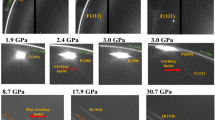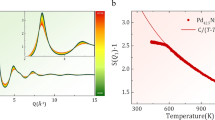Abstract
MOST of the X-ray investigations of liquids have led to a distribution function which cannot be compared directly to the corresponding distribution of atoms in the solid since one peak in the liquid distribution function usually corresponds to several peaks in the distribution function of the solid. For this reason we investigated several years ago the structure of molten salts such as potassium chloride and lithium chloride where one can assign to each peak in the liquid distribution function one peak in the distribution function of the solid. We have shown that the co-ordination in the liquid and the solid is the same; number of first neighbours N1 in the solid equals 6 and in the liquid 5·8. The number of second neighbours N2 in the liquid (K–K or Cl–Cl) is already greatly disturbed; in the solid there are 12 and in the liquid 9·8.
This is a preview of subscription content, access via your institution
Access options
Subscribe to this journal
Receive 51 print issues and online access
$199.00 per year
only $3.90 per issue
Buy this article
- Purchase on Springer Link
- Instant access to full article PDF
Prices may be subject to local taxes which are calculated during checkout
Similar content being viewed by others
References
Fowler, R. H., and Guggenheim, E. A., "Statistical Thermodynamics", § 808, and following.
Eisenstein, A., and Gingrich, N. S. (Bull. Amer. Phys. Soc., 15, No. 2; April 1940) in a preliminary report give 7 atoms at 3.9 A. as nearest neighbours. This result, which seems rather difficult to reconcile with the theoretical predictions, was obtained with an experimental arrangement different from ours and in a different p-T range. It might be pointed out that at higher molal volume the curves of Rice3 indicate a possible change in co-ordination, but scarcely so low as the preliminary results of these authors indicate.
Fowler and Guggenheim, loc. cit., and Rice, O. K., J. Chem. Phys., 7, 136 and 883 (1939).
Author information
Authors and Affiliations
Rights and permissions
About this article
Cite this article
LARK-HOROVITZ, K., MILLER, E. Structure of Liquid Argon. Nature 146, 459–460 (1940). https://doi.org/10.1038/146459b0
Issue Date:
DOI: https://doi.org/10.1038/146459b0
This article is cited by
Comments
By submitting a comment you agree to abide by our Terms and Community Guidelines. If you find something abusive or that does not comply with our terms or guidelines please flag it as inappropriate.



